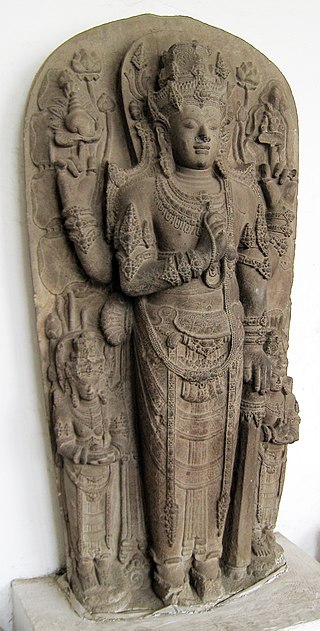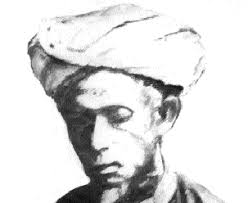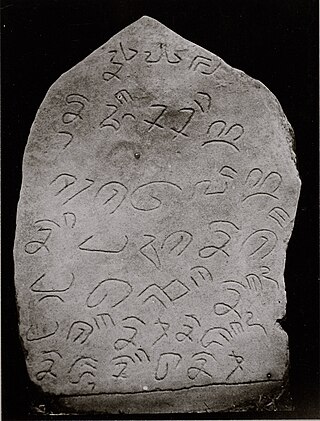
Bendahara is an administrative position within classical Malay kingdoms comparable to a vizier before the intervention of European powers during the 19th century. A bendahara was appointed by a sultan and was a hereditary post. The bendahara and the sultan shared the same lineage.

The Mataram Kingdom ; also known as Medang Kingdom was a Javanese Hindu–Buddhist kingdom that flourished between the 8th and 11th centuries. It was based in Central Java, and later in East Java. Established by King Sanjaya, the kingdom was ruled by the Shailendra dynasty and Ishana dynasty.

Raden Wijaya or Raden Vijaya was a Javanese emperor, and the founder and first monarch of the Majapahit Empire. The history of his founding of Majapahit was written in several records, including Pararaton and Negarakertagama. His rule was marked by the victory against the army and the Mongol navy of Kublai Khan's Yuan dynasty.

Pakuan Pajajaran was the fortified capital city of Sunda Kingdom. The location roughly corresponds to modern Bogor city in West Java, Indonesia, approximately around the site of Batu Tulis. The site is revered as the spiritual home of Sundanese people as it contains much of the shared identity and history of Sundanese people.
Sri Baduga Maharaja or Sang Ratu Jayadewata was the great king of the Hindu Sunda kingdom in West Java, reigned 1482 to 1521 from his capital in Pakuan Pajajaran. He brought his kingdom greatness and prosperity.

Raja Ali Haji bin Raja Haji Ahmad (1808/9–1869/75) was a 19th-century Bugis-Malay historian, poet and scholar who wrote Tuhfal al-Nafis. He was elevated to the status of National Hero of Indonesia in 2004. Haji has been described as one of the most important Malay writers of the 19th century.
Sayyid ʿAbdullāh bin Shaykh al-ʿAydarūs was a Hadhrami religious leader who lived in the 16th century and a descendant of Abu Bakr al-ʿAydarūs, a prominent saint who started the al-ʿAydarūs branch of the Bā ʿAlawiyyah clan.

The Dutch conquest of South Bali in 1906 was a Dutch military intervention in Bali as part of the Dutch colonial conquest of the Indonesian islands, killing an estimated 1,000 people. It was part of the final takeover of the Netherlands East-Indies. The campaign led to the deaths of the Balinese rulers of Badung and Tabanan kingdoms, their wives and children and followers. This conquest weakened the remaining independent kingdoms of Klungkung and Bangli, leading to their invasion two years later. It was the sixth Dutch military intervention in Bali.

Dalem Ketut was a king (Dalem) of Bali who ruled at an uncertain time during the age of the Javanese Majapahit Empire. While first a vassal ruler under the Majapahit kings, he later emerged as the king of a separate island realm. He was also known under the names Sri Smara Kepakisan or Tegal Besung. Dewa Tegal Besung is the earliest deified ruler who is honoured at the Pura Padharman Dalem Gelgel, the most important shrine at the central Balinese temple Pura Besakih.

Patuan Bosar SinambelaginoarOmpu Pulo Batu, better known as Si Singamangaraja XII, was the last priest-king of the Batak peoples of north Sumatra. In the course of fighting a lengthy guerrilla war against the Dutch colonisation of Sumatra from 1878 onwards, he was killed in a skirmish with Dutch troops in 1907. He was declared a National Hero of Indonesia in 1961 for his resistance to Dutch colonialism.

Raden Patah, also known as Jin Bun was the first sultan of the Demak Sultanate. Ascending to the throne in 1475, his remained a vassal of the Majapahit Empire until 1478. Raden Patah took the title Panembahan Jimbun after legitimizing the Sultanate of Demak as the successor state to the Majapahit Empire, with Wali Sanga appointing him as the Sultan of Demak.

The Kingdomship of Bali was a series of Hindu-Buddhist kingdoms that once ruled some parts of the volcanic island of Bali, in Lesser Sunda Islands, Indonesia. With a history of native Balinese kingship spanning from the early 10th to early 20th centuries, Balinese kingdoms demonstrated sophisticated Balinese court culture where native elements of spirit and ancestral reverence combined with Hindu influences—adopted from India through ancient Java intermediary—flourished, enriched and shaped Balinese culture.
Horren inscription is a copperplate inscription measuring 32.6 cm length, 10.6 cm width, discovered in Southern Kediri, in Campur Darat village, Tulungagung, East Java. Initially this inscription was thought to originated from Majapahit period. The examining of the style and linguistic structure this inscription appears to be closer to King Airlangga period of Kahuripan.
King Niskala Wastu Kancana also known as Prabu Raja Wastu or popularly known as Wastu Kancana was one of the great kings of the Sunda Kingdom reigning throughout most of the 15th century. He was the younger brother of Princess Pitaloka.
The Trisandya is a commonly-used prayer in Indian Hinduism and Balinese Hinduism. It is uttered three times each day: 6 am at morning, noon, and 6 pm at evening, in line with the Sandhyavandanam tradition.
Sang Ratu Sri Janasadhu Warmadewa was a king of the Warmadewa dynasty, who ruled Bali around the end of the 10th century CE. Based on various inscriptions, he was the fifth king of the dynasty. King Janasadhu's name has been found in only one inscription, namely the Sembiran inscription, which was dated to 897 Saka.
Çri Maharaja Çri Ragajaya was a Balinese king who ruled in the middle of the 12th century CE. The territory of his kingdom most likely covered only the areas north of Lake Batur and East Bali, mainly from Tejakula in Buleleng Regency to Bugbug in Karangasem Regency. The king's name is mentioned on the Tejakula inscription, dated to 1077 Saka. In the inscription, the king appointed the village of Sabhaya to do the jataka for the benefit of a sacred temple, which was named the Bhatara ri Kunjarasana. In return, the villagers were granted various rights for the obligations they had to do.

Old Sundanese is the earliest recorded stage of the Sundanese language which is spoken in the western part of Java, Indonesia. The evidence is recorded in inscriptions from around the 12th to 14th centuries and ancient palm-leaf manuscripts from the 15th to 17th centuries AD. Old Sundanese is no longer used today, but has developed into its descendant, modern Sundanese.
Kertawijaya or Dyah Kertawijaya was the seventh monarch of Majapahit reigning from 1447 to 1451 by the regnal name Sri Maharaja Wijayaparakramawardhana.










